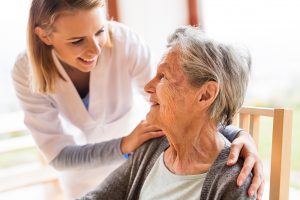First Geriatric Clinic in Southeast Continues Innovations in Assessment

Duke’s Geriatric Evaluation and Treatment (GET) clinic, the first of its kind in the Southeast, continues fast-paced growth that incorporates treatment innovations, broader outreach through population health initiatives, and a commitment to address the increasing challenges presented by dementia.
Created in 1967, GET marks its 50th year with 7 geriatricians, 1 geriatric psychiatrist, and a group of core professionals—the largest team ever. Despite this growth, the clinic remains challenged in meeting the needs of an aging population presenting with complex medical and social problems.
“The clinic’s basic mission and structure have not changed dramatically,” says Mitchell T. Heflin, MD, MHS, medical director. “We perform comprehensive geriatric assessment by reviewing medical, functional, and social factors and then try to integrate those findings to help patients and family members organize their care.”
By exploring population health concepts and virtual consulting partnerships, Medical Director Mitchell T. Heflin, MD, MHS, says the clinic is preparing to offer more services in the future across a broader regional footprint.
A key emphasis is to identify the patient’s goals of care. Because many patients are referred back to a community primary care practice, the GET team works closely with patients and families to agree on care objectives. “We want patients to remain as independent as possible while remaining safe and comfortable,” Heflin says. “But we try to help patients and families achieve some clarity in terms of expectations and advanced care planning.”
To establish care objectives, the GET team must perform certain assessments to determine each patient’s capabilities. This idea of functional assessment was a new concept in the late 1960s and 1970s when GET geriatricians pioneered clinical tools to help evaluate functionality in conjunction with Duke’s Center for the Study of Aging and Human Development. The result was the Older Americans Resources and Services (OARS) model, which leverages valid, reliable instruments to help clinicians make assessments based on data from longitudinal investigations in community, clinical, and long-term-care settings. The OARS program also initiated intensive training for geriatric service providers.
More recently, in a partnership with the Department of Surgery, the GET clinic has developed the Perioperative Optimization of Senior Health (POSH) initiative as a practical solution to bring together surgery, anesthesia, and hospital care teams to help patients and families prepare for surgery and plan for recovery. Early success of the program/initiative prompted an expansion that continues 5 years later.
Programmatic and clinical innovations have characterized GET’s history, but greater challenges are developing as the population ages and conditions like dementia become more prevalent. The GET team is exploring a population-based approach that encourages regional primary care practitioners to utilize virtual consulting through the electronic health records (EHRs) to identify patients who may need geriatric services. Much of this effort is being developed with institutional and community partners, including the Duke University School of Nursing, the Duke Family Support Program, Duke Connected Care, Senior PharmAssist, and Central Pines (formerly Triangle J) Area Agency on Aging.
Heflin acknowledges that the physical location of the GET clinic presents challenges but says an effort is underway to identify more accessible locations as part of a broader emphasis on community outreach. The GET clinic accepts referrals from patients, caregivers, and providers, so the growing emphasis on outreach should help the clinic expand its services.
Importantly, the clinic’s operational success depends on teamwork, Heflin says. “In a clinic like ours, the core staff helps us serve as many patients and families as possible in the most efficient manner,” notes Heflin, who highlights the work of Cornelia Poer, MSW, Lisa Legath, RN, Angeline Smith, LPN, and Gwen Mumford, an administrator.
“You can imagine the challenges of scheduling patients with dementia or reconciling their medications. It’s a complex daily challenge,” Heflin says. “The team is, and always will be, an essential part of the GET clinic’s success.”